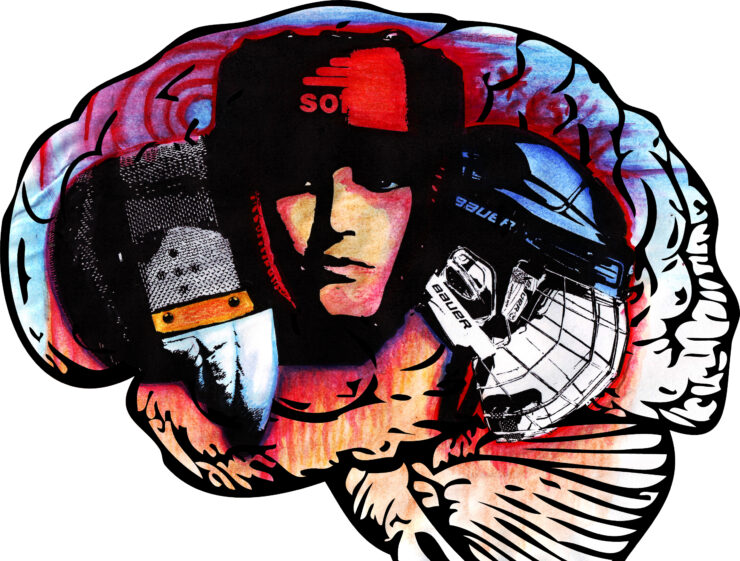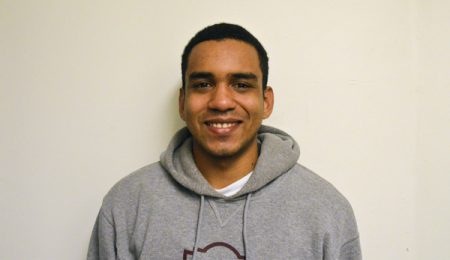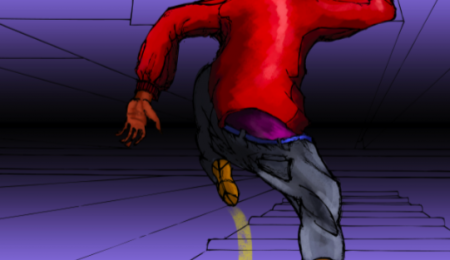Concussions in sports not to be taken lightly
Spencer Van Dyk | Fulcrum Staff
Art by Mathias MacPhee
The risk of concussion is a reality that comes along with many types of sports. By the time athletes reach the university sport level, many of them will have experienced a concussion or several. Dr. Blaine Hoshizaki, a professor at the University of Ottawa, specializes in this type of head injury and is studying the mechanisms of concussions and the risk factors associated with specific sports and injuries. Concussions may seem like a common occurrence, especially within the sports realm, but the damage they can do to your brain is more serious than it might seem.
“The brain is relatively soft,” explained Hoshizaki. “What happens is it actually gets sheared. It’s like Jell-O. If you try to compress it, it won’t compress, but if you shear it, that’s what a concussion is. That’s what people don’t realize, is that the brain is mostly liquid and jelly-like, so it resists compression very well, but shearing it can’t resist. The brain only has to move three to five millimetres, and that’s the damage. The brain is very robust, but if you hit it hard enough, it damages the tissue, and can interfere with the physiology.”
Athletes, especially those who have grown up in the culture of contact sports, are generally familiar with concussions and the risks of head injuries. One such group of athletes is the Gee-Gees women’s hockey team.
“These players have been playing for fifteen or more years, so they’re aware of those dangers,” said hockey coach Yanick Evola. “We just try to talk to them and give them a couple of exercises here and there to help prevent [concussions]. It happens quite a bit. With the girls getting better and better, hitting harder shots and skating faster, they’re at a higher risk, unfortunately. It happened last year, and it happened this year; it’s a pretty frequent thing.”
Hoshizaki seeks to connect the circumstances of the injury with their outcome and effects. According to Hoshizaki, there are two types of injury that could cause concussions: rotational dynamic head injuries and linear dynamic head injuries. These types of injuries cause different stresses and damage to the brain. A rotational dynamic head injury occurs in a situation like being punched in the jaw. Hoshizaki explained that getting hit in the jaw or on the chin can create high angular acceleration, which could knock you out. Alternately, falling and hitting your head, causing it to stop suddenly, is considered a linear dynamic head injury. The consequences of these two types of injuries are comparable, but affect different parts of the brain in different ways.
“What we do primarily is try to understand the mechanisms of concussions and relate the event to the risk of injury,” said Hoshizaki. “If someone has a concussion, we can then recreate the injury to understand how the brain tissue is affected from that particular accident. It’s almost like a forensic [science] in that we take in the information about how the event occurred, and then we reconstruct it so we can get the dynamic response of the head. We then take that dynamic response to the head to create a model of the brain and skull, which allows us to calculate the strain on the brain tissue.”
Samantha Delenardo, a former forward for the Gee-Gees women’s hockey team, said she has experienced three concussions that she can remember.
“My first one was in junior [hockey] before coming to U of O. That was a pretty bad one; I was out for about a month,” she said. “Immediately after I got hit, I forgot the score of the game. I knew where I was, but mostly forgot important details. Since then, I’ve been more susceptible to them. I received my second one in third year—I took a slap shot to the side of the head.… In my last year playing for the Gee-Gees, I got one at practice. I hit a teammate, and she’s a lot heavier than me, so I got the worst of it. I don’t remember much from it. I was benched for about a month and a half.”
According to Delenardo, concussions occur more commonly in sports like hockey, football, and boxing. In the case of football, hits to the head and using the head as a weapon have become basic parts of the sport.
In the case of hockey, says Evola, being at a two-foot distance from the boards puts athletes at a higher risk of being pushed into the boards or falling on the ice—a risk that players are made aware of.
“You don’t really talk about it until it happens, but just growing up in the culture, you’re aware of what a concussion is, and as soon as you have one, obviously you know what the symptoms are and how to treat it a little bit,” she said.
Hoshizaki said the treatment of concussions and other head injuries depends not only on the circumstances, but on the brain itself, and that side effects and consequences of these types of injuries are unpredictable.
“In some cases, people can fall down and get right back up,” said Hoshizaki. “In other cases, they can get knocked out. That is partly because of the parts of the brain that are involved and the effect, so it’s quite unpredictable.”
There are some aspects of concussions that remain a mystery to Hoshizaki.
“What we’re trying to understand is why in some cases, you can have relatively low trauma, but symptoms will persist and possibly never go away. You have to be very careful with when you get back into play. Some studies are showing that even if you show no symptoms, the brain can still be compromised, so you need to be very conservative with getting back into play.”
“[Concussions are] going to happen,” Delenardo said. “It falls on you and it falls on the staff to make sure you take care of it and you can return to the game safely.”





